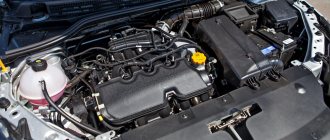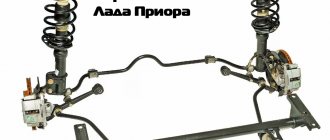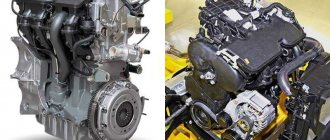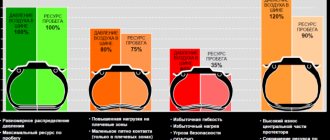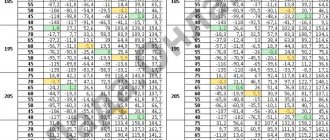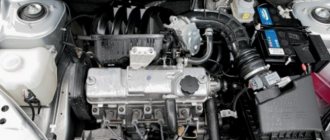Even 3 years ago, rumors began to spread across the Internet about the development of a new 1.8 liter engine at AvtoVAZ. The motor was intended for some new product that was kept secret. Now we already know that this development is the 1.8 Lada Vesta Cross engine. Before this, there had already been attempts to develop a 1.8 engine, which was later successfully assembled by Lada’s subsidiary Super-Auto. This engine had the index 21128 and was even installed on the Lada Priora Sport for some time. But as time has shown, the motor turned out to be unreliable and had a short resource. After which AvtoVAZ gathered its strength again and released a new 1.8 Lada Vesta SV Cross engine, in which all the shortcomings of the 21128 engine were eliminated.
Technical characteristics of the 1.8 Lada Vesta Cross engine
Index - 21179 Volume - 1.8 l Power - 122 hp (at 6050 rpm) Torque - 170 Nm (at 3750 rpm) Emission standard - Euro 5 Fuel - AI92 or AI95 gasoline Average fuel consumption - With manual transmission: Urban cycle - 10.7 l/100 km Extra-urban cycle, 6.4 l /100 km Combined cycle, 7.9 l/100 km - With AMT: Urban cycle - 10.1 l/100 km Extra-urban cycle, 6.3 l/100 km Combined cycle, 7.7 l/100 km
You can find out more about the fuel consumption of the Lada Vesta Cross in our article on the website.
The average engine life is 200,000 km.
Inglorious robot
Cross with an automatic transmission: how the most modern Lada drives
Test drive Lada Xray Cross with a new engine and a new automatic transmission - CVT
In addition, the 1.8 liter engine lacks a modern automatic transmission. The existing “robot” AMT with one clutch is noticeably inferior to other automatic transmissions in terms of smoothness of gear shifting. Despite the fact that AvtoVAZ engineers are constantly improving the AMT - the next version can change gears much faster and is also equipped with a snow mode - this gearbox is not popular. Even though the additional payment for it is low.
For Vesta and Xray, AMT’s share in total sales of cars with a 1.8 engine was around 7%. Only with the advent of the variator paired with the H4M unit (113 hp and 152 Nm) of the Renault-Nissan alliance, the demand for Lada with automatic transmissions began to grow. Despite the lower power of the foreign unit, CVT cars turned out to be not only smoother in acceleration, but also a little more dynamic at the same consumption.
“If there was a fundamental difference in power, for example, a 1.8 engine developed 140 hp, there would be demand. As it is, the difference in power between the engines is small, and there is no point in buying a 122-horsepower one,” says auto expert Igor Morzharetto.
Disadvantages of the 1.8 Lada Vesta Cross SV engine
Engine 21179 was first installed on the new LADA Vesta sedans, which went on sale only at the end of 2021. A year has passed, during which the most common malfunctions of this power unit were identified. Among them:
— Knock of hydraulic compensators. This is a fairly common problem with all 16-valve AvtoVAZ engines. This problem mainly occurs due to insufficient oil in the engine or due to the use of the wrong engine oil. In the worst case, you will have to change non-working hydraulic compensators. I agree that it is not very pleasant, but the procedure is not very expensive and is quite affordable for the average Vesta buyer.
— Increased engine oil consumption. And this is also a common problem with 16-valve VAZ engines. In the vast majority of cases, the only solution is to replace the connecting rod and piston group with a new one. If the car is under warranty, then the dealership will perform this procedure free of charge. If not, you will have to spend money on a replacement.
Otherwise, the 1.8 engine of the Lada Vesta Cross SV showed itself only on the good side. With proper maintenance, such an engine covers 150-200 thousand km without problems. Yes, and the AMT on the Lada Vesta Cross SV has a service life, like that of a conventional mechanic.
Main components
Among the most important elements of this motor, the following should be highlighted:
- valves from the famous Mahle brand;
- Continental timing belt. According to the manufacturer, the service life of this component reaches up to 180 thousand kilometers. In practice, the figure is somewhat smaller, but still very impressive;
- injectors from the same manufacturer. When compared with Priora, the resource here is several times higher, and the performance is somewhat better;
- GMB pumps. Its service life corresponds to the timing belt (180,000 kilometers);
- Toyota Tsusho camshafts. Their weight is an order of magnitude lower than in the case of old cast iron models;
- INA phase adjustment mechanism.
It will also be interesting to read: Women's crossovers: which is the best crossover to choose for a girl
What kind of engine oil should I fill in the 1.8 Lada Vesta Cross SV 2021 engine?
In order to answer the question “What kind of oil to pour into the 1.8 engine of the Lada Vesta Cross 2017”, you need to understand under what conditions the car will be operated. First, let's define viscosity. In this case, AvtoVAZ in the operating instructions for the Lada Vesta SV recommends using the following SAE viscosities:
- 5W-30
- 5W-40
- 10W-40
- 15W-40
But not all viscosities are equally suitable. For example, if the machine is used in cold regions, then it is better to use thinner oils such as 5W-30 or 5W-40. Even 0W-40 oils can be used in new engines with low mileage.
If the car is used only in the warm season or in hot regions, then 10W-40 or even 15W-40 oils are perfect.
Now let's decide on the quality class. The manufacturer recommends using oils with an API quality class of at least SM and an ILSAC quality class of at least GF-4.
I won’t recommend anything regarding the manufacturer, since there are ongoing discussions on this topic. What matters is not which manufacturer, but whether it meets all the requirements and whether it is original oil.
Weak share
Representatives of the Russian auto giant said that Vestas with a 1.8 engine have not been produced since November 2021. It turns out that all this time dealers were selling off the remaining cars. A representative of the car plant emphasized that the 1.8 engine remains on the elevated Cross versions of Xray and Vesta. In addition, Vesta Sport sedans will continue to be equipped with its forced version.
Japan Lada: how the Russian bestseller drives with a new automatic transmission
Test drive Lada Vesta with a 113-horsepower engine and a Japanese CVT
The reason for the reduction in options with the 1.8 engine is low demand. Over the past year, Vesta with this power unit sold 12,058 copies - this is only 11.2% of the total number of cars sold (10,7281 units). Lada Xray has a better situation - 4494 cars, or 23% of the total number (19,286 units).
Does the 1.8 Lada Vesta Cross engine bend valves when the timing belt breaks?
The answer is yes! The 1.8 Lada Vesta Cross SV engine with index 21179 bends the valve when the timing belt breaks. This is a characteristic feature of any modern engine. The thing is that modern cars are trying to squeeze out maximum power without increasing engine size. This is done by lightening the connecting rod and piston group, as well as increasing the compression ratio. In this case, it is impossible to make grooves in the pistons so that if the timing belt breaks, they do not meet the valves. Therefore, if the pump, tension roller jams, or simply breaks the belt, a major engine overhaul is inevitable.
Main disadvantages of the motor
It is worth noting that, although manufacturers took into account the shortcomings of the 21128 engine from the Lada Priora Sport, this engine also has a number of shortcomings. The motor has been available for use for about 2 years, so users have been able to evaluate all its strengths and weaknesses. First of all, it needs to be emphasized here:
- extraneous noise from hydraulic compensators. In principle, knocking noises from this unit are a typical problem with all 16-valve engines made by AvtoVAZ. Basically, the problem occurs due to the fact that there is not enough working fluid in the power unit (it hasn’t been added for a long time, or there is a leak). In addition, the same symptom appears when using low quality oil. If you run everything too hard, you will have to completely replace the hydraulic compensators. It is worth noting that there is nothing wrong with this, since such repairs will cost you very little;
- increased consumption of working fluid. Motors of this type consume quite a lot of oil. As a rule, this occurs in the event of a failure of the connecting rod and piston group. You can get out of this situation only if you completely replace the faulty elements.
It will also be interesting to read: Hyundai Creta 2021: technical specifications, price, equipment
In principle, there are no further special comments regarding the functioning of the Lada Vesta Cross engine. If you maintain it correctly, the unit will last up to 200 thousand kilometers without problems. At the same time, the engines demonstrate excellent performance with both a manual gearbox and automatic transmission. By the way, the resource of the latter is exactly the same as that of the mechanics.
What components are used to assemble the 1.8 Lada Vesta Cross 2107 SV engine?
Many people are probably wondering what parts were used to assemble the 21179 motor. Now we’ll talk about this.
1. Timing belt - Continental. Manufacturers claim that the belt life is about 180 thousand km. I doubt that this is real, but these are the stated figures. Read here how to replace the timing belt of a Lada Vesta SV Cross with your own hands. 2. Injectors - Continental. These injectors have a longer service life than the Priora and also have increased productivity. 3. Valves - Mahle. 4. Pump - GMB. The resource is the same as that of the timing belt - 180 thousand km. 5. Oil pump - GMB. Has improved performance. 6. Camshafts - Toyota Tsusho. The decision to use these RVs was due to the fact that the old cast iron RVs were heavier than Toyota ones. 7. INA phase adjustment mechanism.
Features of the 1.8 engine Lada Vesta SV Cross 2017
Externally, the 21179 engine is very similar to other 16-valve VAZ engines and the 1.6 engine. But it was possible to achieve a volume of 1.8 liters not thanks to an increase in the diameter of the cylinders, but to an increase in the piston stroke in a standard cylinder. To do this, it was necessary to rework the entire connecting rod and piston group, and also install a new crankshaft.
In addition, 21179 is the first VAZ engine to use variable valve timing.
The 1.8 Vesta engine also differs from previous versions in that it has completely redesigned oil and cooling channels.
Due to the increase in engine volume, it was necessary to install new injectors with higher performance, an enlarged throttle valve, and also increase the volume of oil in the engine. The oil pan now holds 4.4 liters of engine oil, and a more efficient oil pump is located under the crankcase. The intake ports are also larger than before.
Another characteristic feature of the 21179 engine was the abandonment of the classic model of using a mass air flow sensor. Now readings are taken using an absolute pressure sensor and an air temperature sensor.
Distinctive features of the engine
Many car enthusiasts rightly note the external similarity of the 21179 engine with early examples of 16-valve VAZ engines and, in particular, with the 1.6 engine. However, it was possible to achieve a larger engine volume compared to 1.6 not by increasing the diameter of the cylinders, but by increasing the piston stroke in the previous cylinder. To realize the idea, it was necessary to remake the connecting rod and piston group and install a new crankshaft.
It is worth noting that the new engine uses variable valve timing, which was not present on any previously released version.
The oil and cooling passages have also changed significantly.
New injectors with increased performance, mentioned above, were needed due to an increase in engine displacement. In addition to them, it was necessary to install a new throttle valve and increase the volume of the oil pan to 4.4 liters. An increase in the volume of oil in the engine entailed the installation of a more efficient pump. The intake ports have also become larger.
It is worth mentioning a new method for reading mass fuel consumption. An absolute pressure sensor and an air temperature sensor are now responsible for this.
Golden "Niva"
The 1.8 engine could replace the ancient and low-power Niva unit, and there were rumors that it would fit under the hood of the Togliatti SUV. However, an experiment with the Chevrolet Niva FAM-1, equipped with an Opel power unit of the same volume, showed that the Niva transmission is working at the limit and requires modifications, and they will ultimately not have the best effect on the price of the SUV.
“People write: is it really difficult for AvtoVAZ to supply a new engine, look, the craftsmen do it. The craftsman does it for himself, and then lies under this engine. It’s one thing when you made two cars, and another thing when you put a car on the market that is backed by a warranty and spare parts. To attach a new gearbox to the engine, it’s not enough to make an adapter; you need to carry out a full cycle of tests on fuel consumption, reliability, select a gear ratio, environmental calibrations,” Maxim Kadakov, editor-in-chief of Za Rulem, told Izvestia.
Dust and splashes: the “people’s” crossover meets the “Caspian monster”
Test drive of the new Renault Duster in Dagestan

